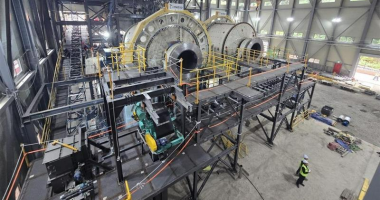Over the years, materials have revolutionised the way we live and work.
Bronze resulted in more durable tools. Iron helped make swords, shields and armour. And the discovery of lead created more advanced roofing and waterways.
But there’s a new material on the world stage; graphene is stronger, smarter and sexier than anything we’ve seen before. And one company reckons this all-rounder will soon be in everything we use.
The new super material
In some ways, graphene defies all logic. It’s the thinnest material that’s ever been isolated, weighing in at just one atom thick. However, its hexagonal network of carbon atoms makes it 200 times stronger than steel. It might be two-dimensional, but it’s one of the sturdiest materials known to man.
Having said that, strength is just one of the properties graphene boasts. It can flex lengthways by up to 20 per cent, is impermeable (even to substances like helium gas), presents as 5000 times more conductive than copper and only absorbs 2.3 per cent of visible light, making it one of the most transparent materials on the market.
On top of that, it’s got waterproofing and thermal management properties, meaning it’s great for coating solar panels or creating electric vehicle batteries.
It’s clear this material is revolutionary — and will someday be in high demand. A recent report from Grand View Research predicts the global graphene market will be worth $1.08 billion by 2027.
Currently, however, there’s an extremely limited commercial supply. So one home-grown company is working hard to get ahead of the market curve.
A graphene pioneer
At the forefront of this magic material is First Graphene (FGR), a world-leading industrial graphene supplier. Headquartered in Australia, the company is working to create composites, elastomers, conductors, textiles, concretes and fire-retardant materials that incorporate graphene.
Why is this key? Because graphene also provides superior durability, making it a unique, revolutionary additive across several industries.
At the First Graphene helm is non-executive chairman Warwick Grigor. And he believes people need to look beyond the properties and focus on getting the material to industry.
“We have people who’ve wanted graphene for a while but they couldn’t get it,” Warwick explains.
“We saw that almost no-one was making graphene in sufficient quantities to supply to industry. So rather than talk about how magical graphene was, we set our sights on being the number one manufacturer. We wanted to develop a supply so the industry could actually adopt it,” he continues.
Being on a pilgrimage to create high quality, low-cost graphene for industry is a tough (but essential) gig.
“We’re not yet operating at full capacity. In fact, we’ve got a way to go before we get there. But we have commenced sales in a number of product verticals that are a good harbinger of what’s to come,” Warwick notes.
“The last couple of years, having commissioned our plant, we’ve been working with customers to design graphene-enhanced products that give substantially better performance in terms of strength and wear resistance, which can also provide coincidental fire retardancy qualities,” he describes.
Resistance in the ranks
Pioneering the supply of commercial graphene is FGR’s main mission, but Warwick says it doesn’t happen overnight.
“It all does take time,” he notes. “That’s a very important thing to appreciate when it comes to what we’re doing. This is going to be a 20 to 30-year growth curve. Whether its two or five or seven years down the track, people are going to be asking ‘does this have graphene in it?’ when they are looking for the best products.”
Of course, a product ready to revolutionise several industries is bound to meet a little resistance.
“Graphene is a disruptive product,” Warwick states. “Where it goes into many uses in industry, it’ll make those products last quite easily 30 to 50 per cent longer.”
“There is resistance from certain manufacturers because they’d rather not have graphene if it means their products will have a longer life. There’s no in-built obsolescence,” he explains.
But Warwick believes this is something FGR can overcome.
“What we’re finding naturally is that some smaller, more aggressive companies that want to climb to the top of the tree are more willing to embrace what we’re doing,” he continues.
In the pipeline
FGR isn’t just focussed on the long term. The company already has clients lining up to buy First Graphene’s products, which are already in high demand across several industries.
Back in February, First Graphene signed an exclusive supply agreement with Steel Blue to provide graphene products for work boots. That came after both companies worked together to create the world’s first graphene-enhanced safety boot.
Additionally, FGR is working closely with the mining industry to make more durable equipment with longer lifespans. Just last week, the company’s customer supplied several graphene-enhanced bucket liners to a second major iron ore producer.
And already, FRG is investigating what other industries they could supply graphene to. On April 8, the company announced its move into the natural rubber industry. First Graphene just started a research program to see how its PureGRAPH powders can be used across several natural rubber product lines.
On the back of that news, FGR shares tacked on an extra two cents.
What’s on the cards for FGR?
As FGR moves to dominate an emerging market, it has its eyes on the prize.
“Fear of change is something we have to overcome,” Warwick notes. “We’ll be treading on the toes of those in cozy positions,” he says.
If there’s one thing the Chairman wants his clients and shareholders to take away, it’s that Rome wasn’t built in a day.
“There’s great potential, and we’re on the path, but so often people want delivery yesterday. The world just doesn’t work like that,” he continues.
In all of this, it seems like First Graphene investors should be prepared to play the long game to maximise their returns, but there could be some rewarding short-term performance as well as new product verticals start to adopt graphene.
“We should be expecting a snowballing effect as sales gather momentum,” Warwick concludes.








